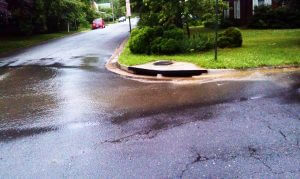Infrastructure Investment? Time for some Integrated Thinking
Eight years ago, Congress invested big-time in infrastructure, including water infrastructure through the American Recovery and Reinvestment Act (ARRA). Investing in our crumbling water infrastructure creates jobs and generates money throughout the economy. Already, there are the beginnings of infrastructure proposals on the table from both Democrats and the Trump Administration. Undoubtedly lots of fighting ahead about what exactly to invest in and how to pay for it.
Both are important – but what we fund is critical. Last time round, the ARRA investment did a good job of catalyzing the use of sustainable water infrastructure approaches like green infrastructure and water efficiency. Since then, we’ve learned more about how to invest in ways that can benefit people and our waterways. Any new water infrastructure investment should consider a more “integrated” approach, and not be an excuse to invest in old, outdated approaches and regulatory rollbacks. This means that we should treat all water – stormwater, drinking water, and wastewater – as one, and engage the community in planning to protect and restore rivers in a way so that economic, social and environmental benefits are distributed equitably.

Stormwater runoff and flooding in Virginia, Lynn Broaddus
But what does this really mean in practice? Recently River Network has facilitated a series of webinars on Integrated Water Management that tell the stories of different communities from Washington to Cincinnati to New Orleans that are taking, or starting to take these approaches. Each community approaches IWM differently, but some common elements include:
- Working across disciplines, departments and political and watershed boundaries
- Seeking multiple benefits – economic, social and environmental – both upstream and down
- Restoring natural hydrology and considering all water (whether drinking water, stormwater or wastewater) as water
- Engaging and listening to a broad range of community members as part of the decision-making process to ensure equitable outcomes
- Considering and planning for the impacts of climate change
- Looking for opportunities that are restorative, regenerative and flexible as opposed to linear, wasteful and rigid
In our recent issue of River Voices, we further explore this topic to learn more. River Network Board Chair Lynn Broadus kicks off with an overview followed a piece from the Pisces Foundation describing their strategy for moving toward more integrated management of freshwater resources. Read on to learn about what’s happening on the ground in San Francisco with the City’s non-potable water program, in Atlanta on engaging local communities on using green stormwater infrastructure to reduce flooding and in New Jersey where people have come together to find ways to upgrade water infrastructure and create community benefits. River Rally will also feature a number of sessions including local applications of IWM in Milwaukee, Atlanta and Boston.
All of these examples provide hope for what we can do when we invest wisely in water infrastructure – some of these stories and principles could well inform any new federal spending on water infrastructure to support clean water and communities.




